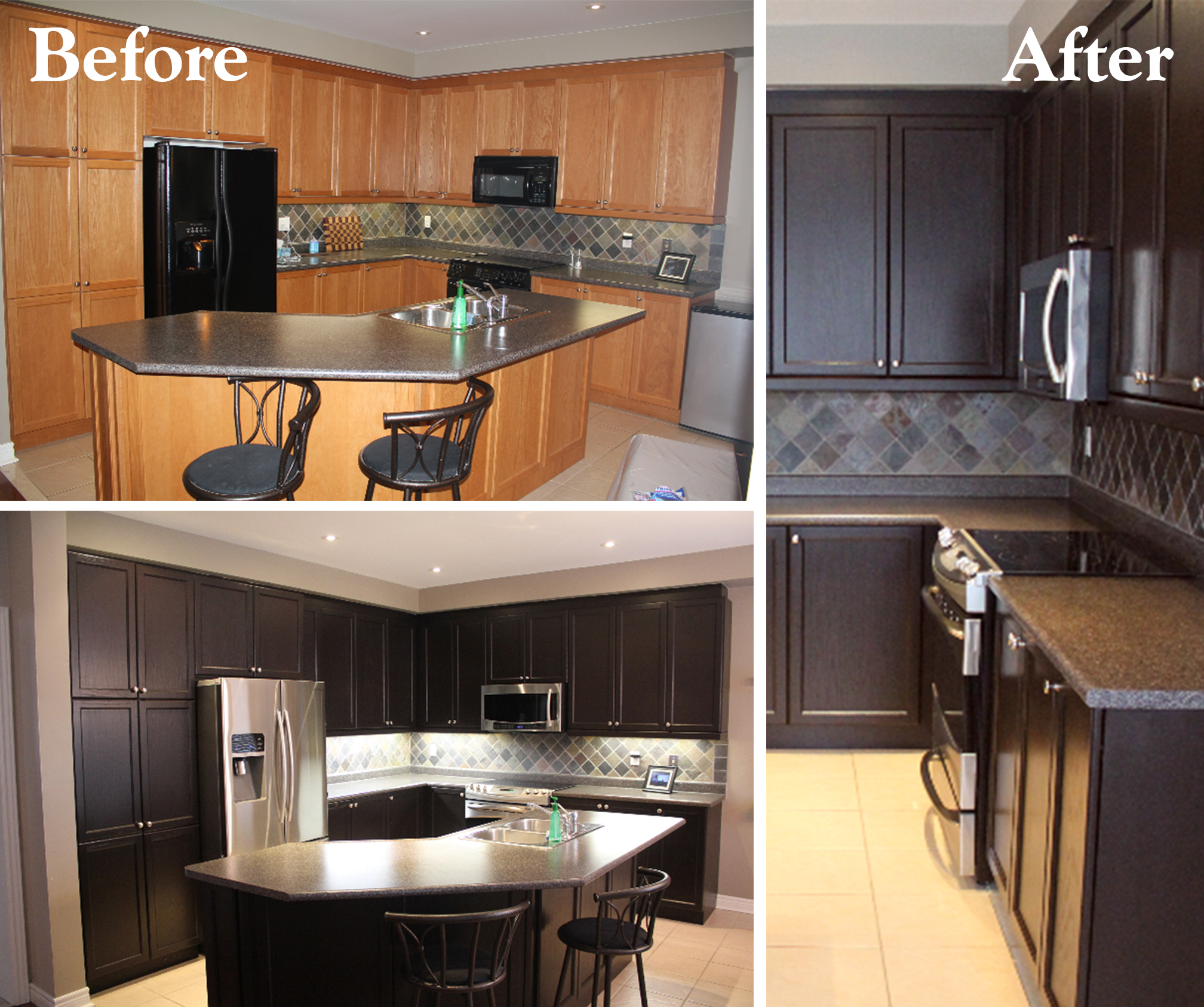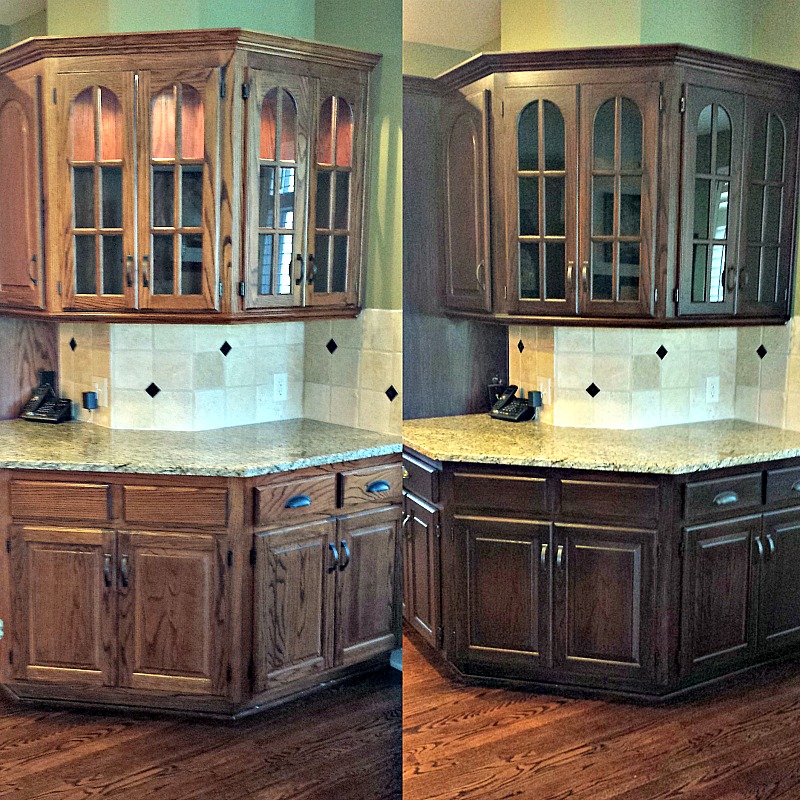Preparing Your Kitchen Cabinets: How Do I Stain My Kitchen Cabinets

Preparing your kitchen cabinets is crucial for achieving a smooth and even stain finish. Cleaning removes dirt, grease, and old finishes, while sanding creates a suitable surface for the stain to adhere to.
Cleaning Your Kitchen Cabinets
Thorough cleaning ensures a clean surface for staining, allowing the stain to penetrate evenly and achieve a consistent color.
- Remove all cabinet doors and hardware. This allows for easier access to all surfaces for cleaning and sanding.
- Remove any existing finishes. Depending on the type of finish, you may need to use a paint stripper, a sanding block, or a combination of both. If you’re dealing with paint, use a paint stripper following the manufacturer’s instructions. For varnish or existing stain, sanding is typically sufficient.
- Clean the cabinets thoroughly. Use a mild detergent and warm water to remove dirt, grease, and grime. Rinse well and allow the cabinets to dry completely.
Sanding Your Kitchen Cabinets, How do i stain my kitchen cabinets
Sanding creates a smooth surface for the stain to adhere to, ensuring an even and professional finish.
- Start with coarse-grit sandpaper (80-120 grit). This removes any remaining old finish and smooths out any imperfections. Sand with the grain of the wood for a consistent finish.
- Progress to finer-grit sandpaper (150-220 grit). This refines the surface and prepares it for staining. Again, sand with the grain of the wood.
- Use a tack cloth to remove any dust. This ensures a clean surface for the stain to adhere to.
Dealing with Different Cabinet Finishes
Different types of cabinet finishes require different preparation methods.
- Paint: Removing paint requires a paint stripper. Apply the stripper following the manufacturer’s instructions, and then remove the softened paint with a scraper. After stripping, sand the surface to smooth out any imperfections.
- Varnish or Existing Stain: Sanding is usually sufficient to remove varnish or existing stain. Start with coarse-grit sandpaper and progress to finer-grit sandpaper. Sand with the grain of the wood to avoid creating scratches.
Choosing the Right Stain

Selecting the right stain for your kitchen cabinets is crucial for achieving the desired look and ensuring durability. The type of stain you choose will affect the color, finish, and longevity of your cabinets.
Types of Wood Stains
Wood stains are available in various types, each with unique characteristics. Understanding these differences will help you make an informed decision.
- Oil-Based Stains: Oil-based stains penetrate deeply into the wood, resulting in rich, vibrant colors. They offer excellent durability and resistance to water damage, making them ideal for high-traffic areas like kitchens. However, oil-based stains have a longer drying time and require proper ventilation due to their strong odor.
- Water-Based Stains: Water-based stains are environmentally friendly and have a shorter drying time than oil-based stains. They offer good color penetration and are easier to clean up. However, water-based stains may not be as durable as oil-based stains and can raise the grain of the wood, requiring sanding before applying a topcoat.
- Gel Stains: Gel stains are thicker than oil or water-based stains, making them ideal for vertical surfaces like cabinets. They are less likely to drip and offer excellent color coverage. Gel stains also provide good durability and resistance to water damage. However, they may not penetrate as deeply as oil-based stains and can take longer to dry.
Factors to Consider When Choosing a Stain
Several factors influence the best stain choice for your kitchen cabinets.
- Wood Species: Different wood species absorb stain differently. For example, hardwoods like oak and maple generally accept stain well, while softer woods like pine may require a pre-stain conditioner to prevent blotching.
- Desired Finish: The desired finish will also determine the best stain type. If you want a deep, rich color, an oil-based stain is a good option. For a lighter, more natural finish, a water-based stain might be preferable.
- Durability: For high-traffic areas like kitchens, durability is crucial. Oil-based stains offer the best durability, while water-based stains are less durable but still provide good protection.
- Drying Time: Oil-based stains have a longer drying time than water-based stains, which can be a factor if you need to complete the project quickly. Gel stains also have a longer drying time than water-based stains.
Best Stain Type for Kitchen Cabinets
Ultimately, the best stain type for your kitchen cabinets depends on your specific needs and preferences.
- For a deep, rich color and excellent durability, oil-based stains are the best choice. They are ideal for hardwoods like oak and maple and can withstand heavy use in a kitchen environment.
- If you prefer a lighter, more natural finish and need a faster drying time, water-based stains are a good option. However, they may not be as durable as oil-based stains and can raise the grain of the wood, requiring sanding before applying a topcoat.
- Gel stains are ideal for vertical surfaces like cabinets and offer good color coverage and durability. They are a good choice if you need a stain that is less likely to drip.
Staining Your Kitchen Cabinets

Now that you have prepped your cabinets and chosen your stain, it’s time to get your hands dirty (figuratively, of course). The actual staining process is where your vision comes to life, and it requires careful attention to detail to achieve the desired results.
Applying Stain to Your Kitchen Cabinets
Applying stain is a delicate process that requires patience and precision. The key is to apply thin, even coats, allowing each coat to dry thoroughly before applying the next. Using a quality brush or applicator is crucial for achieving a smooth and consistent finish.
- Using a Brush: A natural bristle brush is the preferred choice for applying stain to cabinets. It allows for better control and helps to distribute the stain evenly. Dip the brush into the stain, removing excess by wiping it against the inside of the can. Apply the stain in long, even strokes, following the grain of the wood.
- Using a Roller: For larger surfaces, a foam roller can be used to apply stain. Use a roller with a short nap for smoother results. Load the roller with stain, ensuring it is evenly distributed, and apply it in long, even strokes.
- Using a Rag: A clean, lint-free cloth can also be used to apply stain, especially for small areas or intricate details. Dip the rag into the stain, removing excess, and gently rub it onto the surface.
How do i stain my kitchen cabinets – Once you have applied the first coat, allow it to dry completely according to the manufacturer’s instructions. This can take anywhere from a few hours to overnight, depending on the type of stain and the ambient temperature. After the first coat is dry, inspect the surface for any areas that require additional stain. If necessary, apply a second or even third coat, allowing each coat to dry completely before proceeding.
Wiping Technique: After applying the stain, it is important to wipe away any excess with a clean, lint-free cloth. This will help to create an even finish and prevent the stain from pooling in certain areas. Wipe in the direction of the grain to avoid streaking.
Achieving Different Effects: Stain can be used to create a variety of effects, such as distressing or antiquing. For a distressed look, apply the stain to the surface, then use sandpaper or a wire brush to remove some of the stain in areas where wear and tear would naturally occur. For an antiqued effect, apply a darker stain to the surface, then wipe away some of the stain with a damp cloth to reveal the lighter wood underneath.
So you’re thinking about staining your kitchen cabinets, huh? It’s a great way to give your kitchen a whole new look! If you’re going for a dramatic effect, black cabinets are a popular choice. Just remember to choose the right backsplash to complement the dark color – check out these amazing ideas for backsplash for black cabinets ! Once you’ve got your backsplash sorted, you can start prepping those cabinets for staining – the fun part is about to begin!
Want to give your kitchen a whole new look without a complete overhaul? Staining your cabinets is a fantastic way to achieve a dramatic transformation. Seeing the stained cabinets before and after pictures can really inspire you! To get started, you’ll need to choose your stain color, prep the cabinets by cleaning and sanding them, and then apply the stain with a brush or cloth.
Remember to let the stain dry completely before applying a sealant for a durable finish.